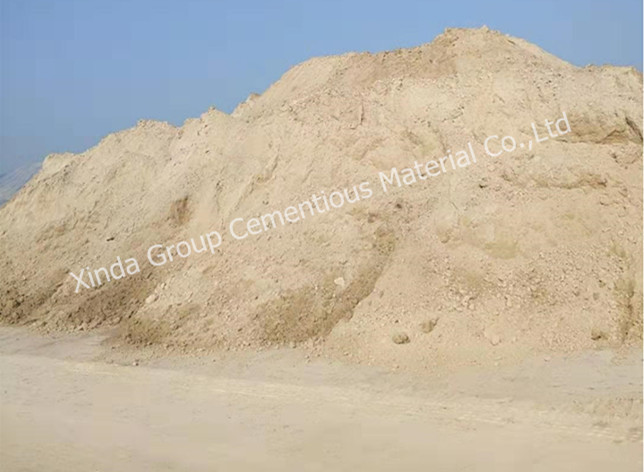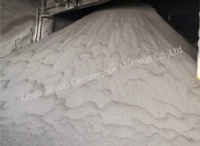Xinda Group Cementious Material Co.,Ltd
FGD gypsum
Product name : FGD gypsum
Details :characteristic:
(1) hydration kinetics and coagulation characteristics consistent;
(2) The main mineral phases, five forms transformed, seven variants materialized consistent performance;
(3) both non-radioactive, is not hazardous to health.
effect :
Increase cement strength, increase cement setting time, increase shrinkage rate and improve the flow of cement mortar, grout flow expansion and other properties.
ingredient:
Like the main component of natural gypsum, calcium sulfate dihydrate, content greater than or equal to 93%
use:
Used as cement retarder it can also be used in the construction of gypsum board factory
Function:
Improvement of cement strength, increase setting time of cement,
To improve the dry shrinkage, Improve the cement mortar flow, paste flow expansion properties
Used of the FGB gypsum
Used as cement retarder, gypsum board can also be used for the factory building
Ingredient
As the main ingredient and natural gypsum, CaSo4.2H2O, content is greater than or equal to 93%
Brief introduction
Gypsum Gypsum is a way to sample the comprehensive utilization of the flue. The portion of the gypsum and industrial or agricultural potassium chloride solution containing ammonium carbonate added together to prepare a crude potassium sulfate and ammonium chloride; the rest of the gypsum and 20 to 30% ammonium sulfate solution preparation of saturated ammonium carbonate solution reaction, the resulting carbonate Calcium can be returned for re-use or for desulfurization cement, metallurgy and other uses, ammonium sulfate solution was mixed with some or all of the crude potassium, phosphoric acid or phosphate is added into the reaction crops with fertilizer; ammonium chloride can also be made of multi-element compound fertilizer. This method is applicable to a variety of gypsum processing and use in small ammonium bicarbonate nitrogen fertilizer plant transformation.
2 calcining
Calcined gypsum dry and wet divided into two categories, to produce products for the α β gypsum powder gypsum powder. The main object of our study is building gypsum powder, namely β gypsum powder. The development trend of the gypsum calcination process is as follows: from the intermittent expect a continuous discharge; heating from direct to indirect heating; dehydration from slow to rapid dehydration. Now commonly calcined gypsum production methods and equipment are summarized as follows: 1 indirect heating mode: continuous wok, heat the inner tube rotary kiln, fluidized bed furnace; 2 direct heating method: air-calcination, Shashi Ji polished, Peter Germany mill; 3. direct thermal rotary kiln; 4. fluidized bed calciner, gypsum drying machines.
LD calcined gypsum fluidized bed technology is one of the country's most advanced technology of calcined gypsum, LD plaster fluidized bed calciner is based on fluidized bed roaster on the development of a new type calcining apparatus is a It can handle large quantities of gypsum, gypsum, natural gypsum calcination devices. The successful development of calcined gypsum LD fluidized bed technology makes industrial by-product gypsum can be widely used. From the industrial policy point of view, you can make the plant gypsum, phosphate fertilizer byproduct gypsum proper treatment and effective utilization, environmental protection industries related industries to promote the healthy and rapid development of its, and can save natural gypsum resources, lifting production enterprises worries. LD calcined gypsum fluidized bed technology has been successfully applied in powder, blocks, plates and other new building materials, gypsum products production.
Fluidized technology in modern industry for the first time large-scale application by German winkler for coal gasification gas - solid fluidized bed began. The first set of oil catalytic fluidized bed reactor built in 1942 in the United States, because of its technically sound and a large number of industrial demand, the reactor was quickly popular worldwide, and has been widely applied to other areas of reference . The earliest studies of the fluidized bed technology is academician Wang Jiading research on fluidized-bed lignite low temperature distillation technology, it is one of the pioneers of the world will turn to fluidized bed technology to develop coal chemical industry. 1978 by the Hangzhou Institute of new building materials industrial design engineers Su Yongping Harbin calcined gypsum plaster MILL workshop for the first time using steam as a heat source to boil single room firing furnace production building gypsum, raw materials used natural gypsum, after grinding calcined. However, due to the presence of grain size composition of raw materials, changes in terms of moisture content, calcined gypsum poor quality stability reasons, does not solve the high moisture content of the material is easy to agglomerate during calcination to produce bed blocking phenomenon. In 1996, Shandong Salt company in the construction of gypsum board factory, designed a two-compartment with oil as a heat source to boil the calciner, after further transformation to improve the use of the furnace firing moisture content <5% of natural gypsum powder, good effect, present, Shandong has more production lines in operation, running in good condition.
Currently, the fluidized technology as a highly efficient heat transfer technology has penetrated into many sectors of the economy, but several key issues in the technical aspects of calcined gypsum need to be addressed, such as the moisture content of the raw material adaptability, material grain size composition there is waste heat utilization problem has not been solved. Weifang days Jie Environmental Technology Co., Ltd. from home and abroad on the basis of relevant expertise, integration advantages of fluidized gypsum calcining equipment at home and abroad, the development of semi-water gypsum powder production line gypsum -LD fluidized bed firing system, initially solved the flow state of the art in the adaptability of calcined gypsum process. The system keeps the energy-saving technology in fluidized calcining natural gypsum, maintenance-free characteristics, and is particularly suitable for calcination moisture content of 25% or less of various chemical gypsum, such as FGD gypsum, phosphogypsum, gypsum and other citric acid. The firing system can produce a stable building gypsum powder meet the national standard requirements, compared with the traditional firing systems, investment, low operating cost, energy-saving and environmental protection have reached a satisfactory result
3 Features
The same point of gypsum and natural gypsum
(1) hydration kinetics and coagulation characteristics consistent;
(2) The main mineral phases, five forms transformed, seven variants materialized consistent performance;
(3) both non-radioactive, is not hazardous to health. Different points of gypsum and natural gypsum
(1) The original physical state are not the same: natural gypsum blocks are bonded together, and gypsum crystals separate particles exist; grindability larger difference between the gypsum plaster impurities, milled natural gypsum After coarse particles mostly impurities, and particle gypsum plaster but for many, the fine particles of impurities, characterized with natural gypsum opposite;
(2) particle size and grading: FGD gypsum average particle size distribution with a more narrow, high fineness (200 mesh or more) between the particles mainly in 30-60μm, graded far worse than natural gypsum plaster ground after.
(3) high water content, water content is generally about 10% or even higher, liquidity is poor, only suitable conveyor belt.
(4) differences on impurities, leading to its dehydration properties, grindability and calcined plaster powder different in mechanical properties, rheological properties and other macro features.
(5) Gypsum output is more evenly distributed across the country, especially plaster products of mass consumption to the eastern region of gypsum production is also great, and gypsum grade and high, generally above 90%; this to make up our natural gypsum reserves of high-grade, low yield, its product away from consumption to significant deficiencies.





